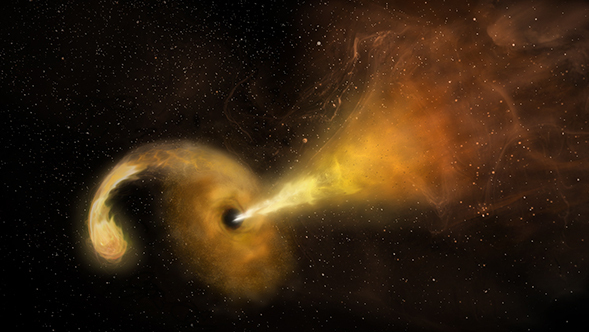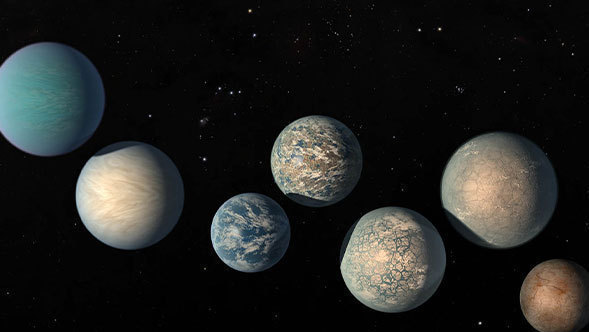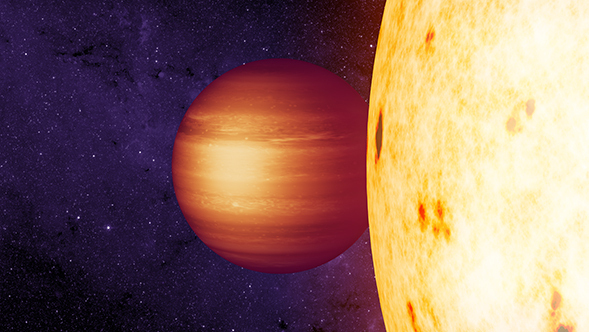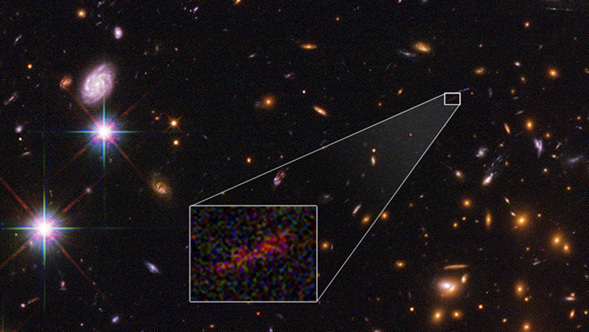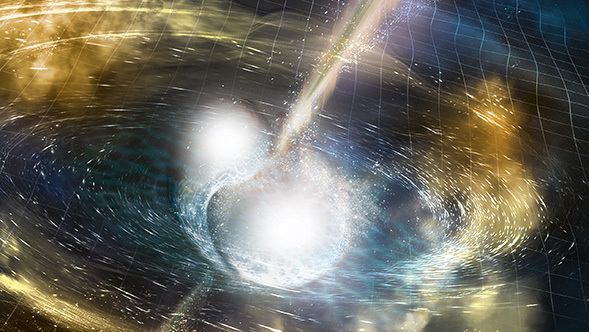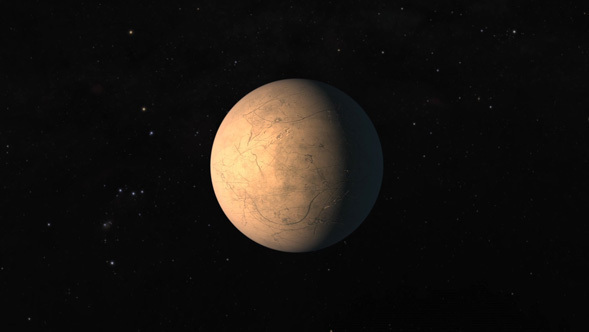Displaying news 61 - 90 of 587 in total
Using data from NASA's Kepler space telescope, citizen scientists have discovered a planet roughly twice the size of Earth located within its star's habitable zone, the range of orbital distances where liquid water may exist on the planet's surface. The new world, known as K2-288Bb, could be rocky or could be a gas-rich planet similar to Neptune. Its size is rare among exoplanets - planets beyond our solar system.
Researchers have discovered a young star in the midst of a rare growth spurt—a dramatic phase of stellar evolution when matter swirling around a star falls onto the star, bulking up its mass. The star belongs to a class of fitful stars known as FU Ori's, named after the original member of the group, FU Orionis (the capital letters represent a naming scheme for variable stars, and Orionis refers to its location in the Orion constellation). Typically, these stars, which are less than a few million years old, are hidden behind thick clouds of dust and hard to observe.
We are all, quite literally, made of star dust. Many of the chemicals that compose our planet and our bodies were formed directly by stars. Now, a new study using observations by NASA's Spitzer Space Telescope reports for the first time that silica - one of the most common minerals found on Earth - is formed when massive stars explode.
In November 2017, scientists pointed NASA's Spitzer Space Telescope toward the object known as 'Oumuamua - the first known interstellar object to visit our solar system. The infrared Spitzer was one of many telescopes pointed at 'Oumuamua in the weeks after its discovery that October.
This image from NASA's Spitzer Space Telescope shows the Cat's Paw Nebula, so named for the large, round features that create the impression of a feline footprint. The nebula is a star-forming region in the Milky Way galaxy, located in the constellation Scorpius. Estimates of its distance from Earth range from about 4,200 to about 5,500 light-years.
Initially scheduled for a minimum 2.5-year primary mission, NASA's Spitzer Space Telescope has gone far beyond its expected lifetime and is still going strong after 15 years.
NASA’s Spitzer Space Telescope is celebrating 15 years since its launch on August 25, 2003. This remarkable spacecraft has made discoveries its designers never even imagined. Here are some key facts about Spitzer:
The Spitzer Space Telescope is one of NASA's Great Observatories, designed to observe the universe in infrared light. It was launched in 2003 with an expected lifetime of 5 years. Spitzer has succeeded beyond our wildest expectations, now routinely observing transiting exoplanets and other interesting astronomical phenomena in its 15th year of operations.
Imagine a place where the weather forecast is always the same: scorching temperatures, relentlessly sunny, and with absolutely zero chance of rain. This hellish scenario exists on the permanent daysides of a type of planet found outside our solar system dubbed an "ultrahot Jupiter."
Thin, red veins of energized gas mark the location of one of the larger supernova remnants in the Milky Way galaxy in this image from NASA's Spitzer Space Telescope.
For the first time, astronomers have directly imaged the formation and expansion of a fast-moving jet of material ejected when the powerful gravity of a supermassive black hole ripped apart a star that wandered too close to the massive monster.
Much like detectives who study fingerprints to identify the culprit, scientists used NASA’s Hubble and Spitzer space telescopes to find the “fingerprints” of water in the atmosphere of a hot, bloated, Saturn-mass exoplanet some 700 light-years away. And, they found a lot of water. In fact, the planet, known as WASP-39b, has three times as much water as Saturn does.
In the year since NASA announced the seven Earth-sized planets of the TRAPPIST-1 system, scientists have been working hard to better understand these enticing worlds just 40 light-years away. Thanks to data from a combination of space- and ground-based telescopes, we know more about TRAPPIST-1 than any other planetary system besides our solar system.
The hottest point on a gaseous planet near a distant star isn’t where astrophysicists expected it to be – a discovery that challenges scientists’ understanding of the many planets of this type found in solar systems outside our own.
Astronomers and visualization specialists from NASA's Universe of Learning program have combined visible and infrared vision of the Hubble and Spitzer space telescopes to create an unprecedented, three-dimensional, fly-through view of the picturesque Orion Nebula, a nearby star-forming region.
An intensive survey deep into the universe by NASA's Hubble and Spitzer space telescopes has yielded the proverbial needle-in-a-haystack: the farthest galaxy yet seen in an image that has been stretched and amplified by a phenomenon called gravitational lensing.
A NASA-led team has found evidence that the oversized exoplanet WASP-18b is wrapped in a smothering stratosphere loaded with carbon monoxide and devoid of water. The findings come from a new analysis of observations made by the Hubble and Spitzer space telescopes.
A super-Earth exoplanet thought to sport lava lakes on its hot side, 55 Cancri e, likely also wears an atmosphere with ingredients similar to Earth's, a new study indicates.
Beneath an elegant office building with a Spanish-style red tiled roof in Pasadena, California, three timeworn storerooms safeguard more than a century of astronomy. Down the stairs and to the right is a basement of wonder.
A deep look back to the early universe by NASA's Spitzer Space Telescope has revealed a surprisingly rowdy bunch of galaxies. Within a large galaxy sample observed 1.5 billion years after the Big Bang, Spitzer witnessed around 15 percent of galaxies undergoing bouts of extreme starmaking, called starbursts.
For the first time, NASA scientists have detected light tied to a gravitational-wave event, thanks to two merging neutron stars in the galaxy NGC 4993, located about 130 million light-years from Earth in the constellation Hydra.
NASA is seeking information from U.S. parties interested in operating the Spitzer Space Telescope with non-NASA funding after March 2019, when NASA financial support ends.
A study finds that giant exoplanets that orbit far from their stars are more likely to be found around young stars that have a disk of dust and debris than those without disks.
One of the most mysterious stellar objects may be revealing some of its secrets at last. Called KIC 8462852, also known as Boyajian’s Star, or Tabby's Star, the object has experienced unusual dips in brightness
Dim objects called brown dwarfs, less massive than the Sun but more massive than Jupiter, have powerful winds and clouds -- specifically, hot patchy clouds made of iron droplets and silicate dust. Scientists recently realized these giant clouds can move and thicken or thin surprisingly rapidly, in less than an Earth day, but did not understand why.
Researchers say in a new study that the TRAPPIST-1 star is quite old: between 5.4 and 9.8 billion years. This is up to twice as old as our own solar system, which formed some 4.5 billion years ago.
How do you visualize distant worlds that you can't see? IPAC's Robert Hurt and Tim Pyle are featured in a new video produced by JPL that highlights how they use scientific data to imagine exoplanets and other astrophysical phenomena.
Astronomers have watched as a massive, dying star was likely reborn as a black hole.
Scientists using NASA's Kepler space telescope identified a regular pattern in the orbits of the planets in the TRAPPIST-1 system that confirmed suspected details about the orbit of its outermost and least understood planet, TRAPPIST-1h.
A study combining observations from NASA’s Hubble and Spitzer space telescopes reveals that the distant planet HAT-P-26b has a primitive atmosphere composed almost entirely of hydrogen and helium.
Displaying news 61 - 90 of 587 in total










